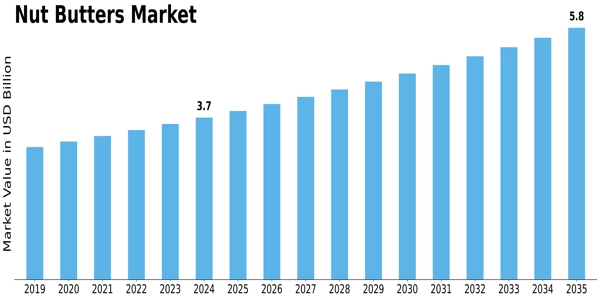
Nut Butters Market Size to Hit USD 6.01 Billion by 2035 | Rising Demand for Plant-Based and Dairy-Free Spreads Drives Growth
The global Nut Butters Market is undergoing robust expansion as consumer preferences continue to shift toward plant-based, protein-rich, and dairy-free alternatives. According to Market Research Future, the market was valued at USD 3.70 billion in 2024 and is projected to reach USD 6.01 billion by 2035, growing at a CAGR of 4.50% during the forecast period (2025–2035). The market’s growth is driven by the rising prevalence of lactose intolerance, increasing awareness of plant-based nutrition, and growing consumer inclination toward healthy and natural food spreads.
Market Overview
Nut butters, made from various nuts such as peanuts, almonds, cashews, walnuts, and hazelnuts, have become a staple in health-conscious households globally. Traditionally dominated by peanut butter, the market has diversified rapidly, with almond, cashew, and mixed-nut butters gaining traction due to their superior nutritional profiles and perceived health benefits. Consumers today are seeking clean-label, non-GMO, and organic options, driving innovation and product diversification across the category.
The market expansion is further fueled by the rising demand for vegan and lactose-free products, especially among consumers with dietary restrictions or ethical preferences. As consumers increasingly prioritize plant-based protein sources, nut butters have emerged as a versatile and nutritious alternative to dairy-based spreads.
Key Market Drivers
1. Rising Lactose Intolerance and Dairy-Free Trends
An increasing number of consumers are adopting dairy-free lifestyles due to lactose intolerance or milk allergies. This shift is accelerating demand for non-dairy butter alternatives, positioning nut butters as an ideal replacement for traditional dairy spreads. With the plant-based foods movement gaining global momentum, nut butters have found widespread acceptance as a functional, allergen-free, and nutrient-rich option.
2. Growing Popularity of Plant-Based Diets
The rapid adoption of plant-based and vegan diets is one of the primary factors driving the nut butters market. As consumers become more aware of the environmental and ethical implications of animal agriculture, plant-based foods are witnessing exponential growth. Nut butters are now viewed not just as spreads, but as protein supplements, smoothie ingredients, and key components of healthy snacks.
3. Health and Nutritional Benefits
Nut butters are rich in healthy fats, protein, fiber, vitamins, and antioxidants, making them highly appealing to health-conscious consumers. The nutritional value of almonds, cashews, and walnuts — known to support heart health, manage cholesterol, and provide sustained energy — is boosting their inclusion in daily diets. Additionally, growing awareness regarding clean-label and minimally processed foods supports premium product launches in this category.
4. Product Innovation and Flavor Diversification
Manufacturers are introducing innovative variants such as flavored nut butters, chocolate-infused blends, and superfood-enriched formulations featuring chia, flax, or hemp seeds. The increasing availability of organic and sugar-free nut butters has also attracted fitness enthusiasts and consumers seeking low-calorie, high-protein alternatives. This innovation-driven landscape is expected to accelerate growth in the coming decade.
Market Segmentation Insights
By Nut Type
Almond Butter: Expected to register the highest growth rate through 2035, driven by its rich nutritional value and versatility in baking and smoothies.
Peanut Butter: While still the most consumed type globally, peanut butter’s growth is expected to be slower due to health concerns related to aflatoxin contamination and allergies.
Cashew, Walnut, and Hazelnut Butters: These segments are gaining popularity among premium consumers and the clean-label category due to their unique flavor profiles and higher nutrient density.
By Distribution Channel
The market is segmented into supermarkets & hypermarkets, online retail, convenience stores, and specialty stores. The online retail segment is expanding rapidly due to the surge in e-commerce and consumer preference for doorstep delivery and a wider variety of products.
Regional Insights
North America: The Market Leader
North America dominates the global nut butters market, driven by the widespread adoption of plant-based diets, high disposable income, and strong brand presence of key players like J.M. Smucker, Justin’s, and Barney Butter. The U.S. market, in particular, is witnessing robust growth in almond and cashew butter sales, as consumers seek alternatives to traditional peanut butter.
Europe: Rapid Growth in Premium Segments
Europe follows closely, with rising demand for organic and sustainable nut butters. Consumers in countries like the U.K., Germany, and France are increasingly choosing natural, clean-label spreads that align with eco-conscious and vegan lifestyles.
Asia-Pacific: Emerging Opportunities
The Asia-Pacific region is expected to experience the fastest growth due to increasing awareness of Western dietary habits, growing middle-class populations, and the expansion of health food retail networks. Countries like India, China, and Japan are emerging as promising markets for both domestic and international brands.
Future Outlook
The Global Nut Butters Market is poised for sustained growth as health, convenience, and sustainability continue to shape consumer purchasing behavior. The next decade will see an influx of functional, fortified, and flavored nut butter products, aligning with modern lifestyles and nutritional needs. Companies investing in R&D, digital marketing, and sustainable sourcing are likely to gain a competitive advantage.
As consumers increasingly embrace plant-based living, nut butters will remain at the forefront of this global dietary evolution — combining taste, nutrition, and ethical consumption in one versatile product.
Market Overview
Nut butters, made from various nuts such as peanuts, almonds, cashews, walnuts, and hazelnuts, have become a staple in health-conscious households globally. Traditionally dominated by peanut butter, the market has diversified rapidly, with almond, cashew, and mixed-nut butters gaining traction due to their superior nutritional profiles and perceived health benefits. Consumers today are seeking clean-label, non-GMO, and organic options, driving innovation and product diversification across the category.
The market expansion is further fueled by the rising demand for vegan and lactose-free products, especially among consumers with dietary restrictions or ethical preferences. As consumers increasingly prioritize plant-based protein sources, nut butters have emerged as a versatile and nutritious alternative to dairy-based spreads.
Key Market Drivers
1. Rising Lactose Intolerance and Dairy-Free Trends
An increasing number of consumers are adopting dairy-free lifestyles due to lactose intolerance or milk allergies. This shift is accelerating demand for non-dairy butter alternatives, positioning nut butters as an ideal replacement for traditional dairy spreads. With the plant-based foods movement gaining global momentum, nut butters have found widespread acceptance as a functional, allergen-free, and nutrient-rich option.
2. Growing Popularity of Plant-Based Diets
The rapid adoption of plant-based and vegan diets is one of the primary factors driving the nut butters market. As consumers become more aware of the environmental and ethical implications of animal agriculture, plant-based foods are witnessing exponential growth. Nut butters are now viewed not just as spreads, but as protein supplements, smoothie ingredients, and key components of healthy snacks.
3. Health and Nutritional Benefits
Nut butters are rich in healthy fats, protein, fiber, vitamins, and antioxidants, making them highly appealing to health-conscious consumers. The nutritional value of almonds, cashews, and walnuts — known to support heart health, manage cholesterol, and provide sustained energy — is boosting their inclusion in daily diets. Additionally, growing awareness regarding clean-label and minimally processed foods supports premium product launches in this category.
4. Product Innovation and Flavor Diversification
Manufacturers are introducing innovative variants such as flavored nut butters, chocolate-infused blends, and superfood-enriched formulations featuring chia, flax, or hemp seeds. The increasing availability of organic and sugar-free nut butters has also attracted fitness enthusiasts and consumers seeking low-calorie, high-protein alternatives. This innovation-driven landscape is expected to accelerate growth in the coming decade.
Market Segmentation Insights
By Nut Type
Almond Butter: Expected to register the highest growth rate through 2035, driven by its rich nutritional value and versatility in baking and smoothies.
Peanut Butter: While still the most consumed type globally, peanut butter’s growth is expected to be slower due to health concerns related to aflatoxin contamination and allergies.
Cashew, Walnut, and Hazelnut Butters: These segments are gaining popularity among premium consumers and the clean-label category due to their unique flavor profiles and higher nutrient density.
By Distribution Channel
The market is segmented into supermarkets & hypermarkets, online retail, convenience stores, and specialty stores. The online retail segment is expanding rapidly due to the surge in e-commerce and consumer preference for doorstep delivery and a wider variety of products.
Regional Insights
North America: The Market Leader
North America dominates the global nut butters market, driven by the widespread adoption of plant-based diets, high disposable income, and strong brand presence of key players like J.M. Smucker, Justin’s, and Barney Butter. The U.S. market, in particular, is witnessing robust growth in almond and cashew butter sales, as consumers seek alternatives to traditional peanut butter.
Europe: Rapid Growth in Premium Segments
Europe follows closely, with rising demand for organic and sustainable nut butters. Consumers in countries like the U.K., Germany, and France are increasingly choosing natural, clean-label spreads that align with eco-conscious and vegan lifestyles.
Asia-Pacific: Emerging Opportunities
The Asia-Pacific region is expected to experience the fastest growth due to increasing awareness of Western dietary habits, growing middle-class populations, and the expansion of health food retail networks. Countries like India, China, and Japan are emerging as promising markets for both domestic and international brands.
Future Outlook
The Global Nut Butters Market is poised for sustained growth as health, convenience, and sustainability continue to shape consumer purchasing behavior. The next decade will see an influx of functional, fortified, and flavored nut butter products, aligning with modern lifestyles and nutritional needs. Companies investing in R&D, digital marketing, and sustainable sourcing are likely to gain a competitive advantage.
As consumers increasingly embrace plant-based living, nut butters will remain at the forefront of this global dietary evolution — combining taste, nutrition, and ethical consumption in one versatile product.


